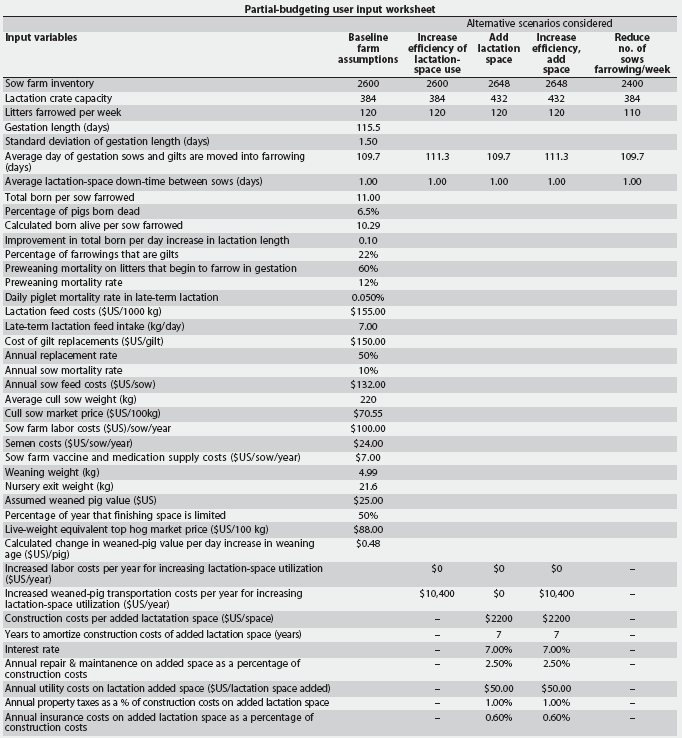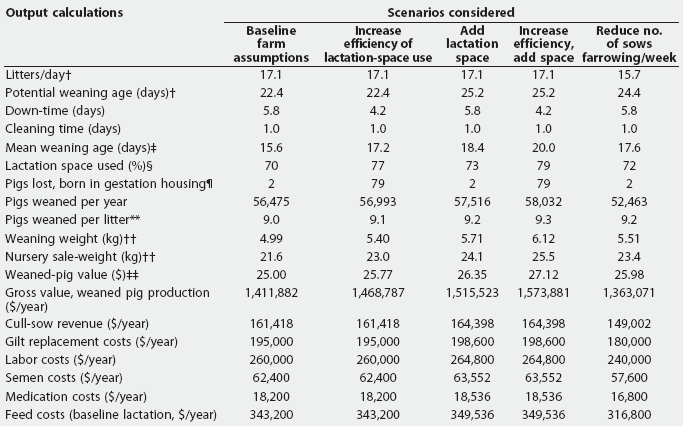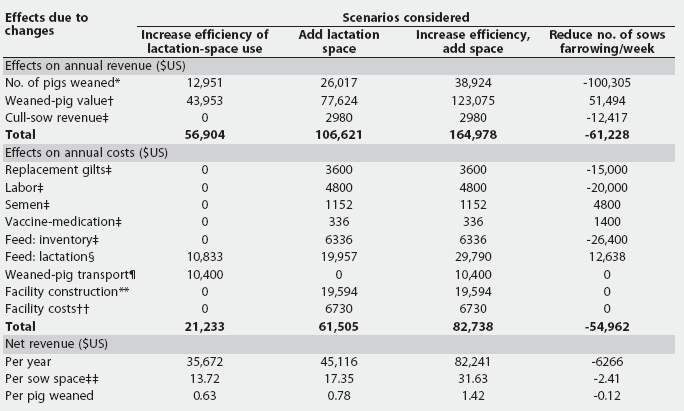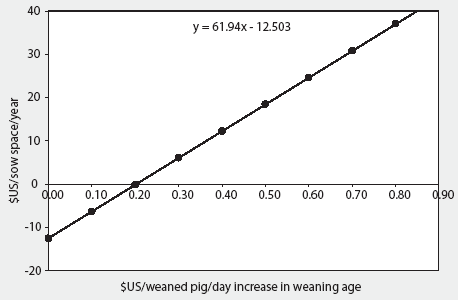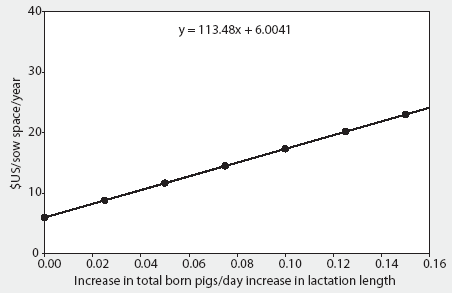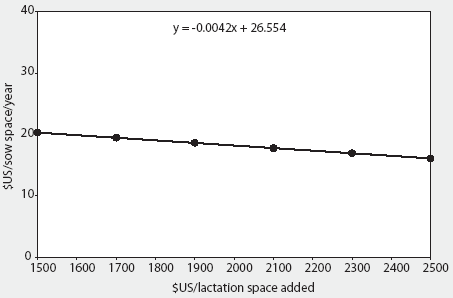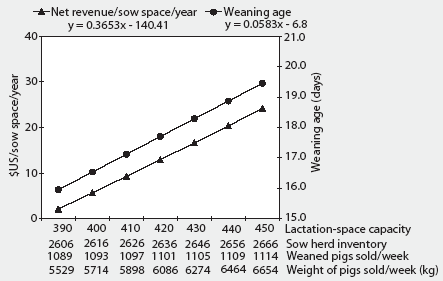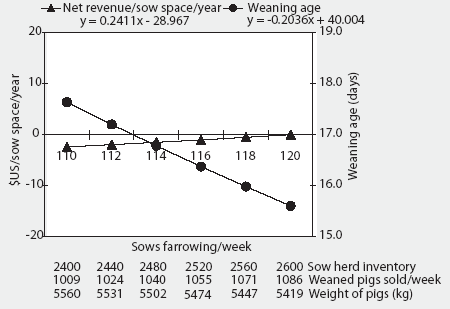Production tool |
Peer reviewed |
A partial-budgeting tool to describe the effect of lactation space and lactation-space management on net revenue in a multi-site production system
El presupuesto parcial como una herramienta para describir el efecto del espacio en lactancia y el manejo del espacio en lactancia sobre el retorno neto en un sistema de producción de sitios múltiples
Budget partiel, un outil pour décrire l'effet de l'espace dans la lactation et la gestion de l'espace dans la lactation sur le revenu net dans un système de la production des sites multiples
Rodger G. Main, DVM, PhD; Steve S. Dritz, DVM, PhD; Mike D. Tokach, PhD; Robert D. Goodband, PhD; Kevin C. Dhuyvetter, PhD; Jim L. Nelssen, PhD
RGM, SSD: Food Animal Health and Management Center and Department of Animal Sciences and Industry, Kansas State University, Manhattan, Kansas. MDT, RDG, JLN: Department of Animal Sciences and Industry, Kansas State University, Manhattan, Kansas. KCD: Department of Agricultural Economics, Kansas State University, Manhattan, Kansas. Corresponding author: Dr Rodger G. Main, 301 Alexander Avenue, Suite B, Ames, IA 50010; Tel: 515-663-9296; Fax: 515-663-9297; E-mail: rodgermain@murphybrownllc.com.
Cite as: Main RG, Dritz SS, Tokach MD, et al. A partial-budgeting tool to describe the effect of lactation space and lactation-space management on net revenue in a multi-site production system. J Swine Health Prod. 2005;13(6):322-332.
Also available as a PDF.
SummaryPartial budget analysis is an effective production tool to evaluate economic implications of proposed changes to pig production systems. We describe a partial-budgeting tool that estimates the effects of lactation space and lactation-space management on net revenue in a multi-site production system. A partial-budgeting worksheet is linked to an economic model that couples production-system-specific input and prospectively derived research data. A 2600-sow multi-site production system is modeled to illustrate the interactions between lactation-space management, weaning age, and whole-system net revenue. The results of these modeling efforts suggest that inadequate lactation space and poor utilization of lactation space substantially restrict net revenue in multi-site pig production. However, decreasing the number of sows scheduled to farrow each week for the purpose of increasing weaning age may not improve profitability. Quantifying the effects of lactation length on weaned-pig value and subsequent reproductive performance enables a clear understanding of the effects of lactation space and lactation-space management on whole-system net revenue. | ResumenEl presupuesto parcial es una herramienta efectiva de producción para evaluar las implicaciones económicas de los cambios propuestos a los sistemas de producción. Aquí describimos la utilización del presupuesto parcial como una herramienta para estimar el efecto del espacio en lactancia y el manejo del espacio en lactancia sobre el retorno neto en un sistema de sitios múltiples. Una hoja de cálculo de presupuesto parcial está ligada a un modelo económico que aparea los datos de producción específicos de un sistema y la información prospectiva derivada de una investigación científica. Se modeló un sistema de producción de sitios múltiples de 2600 hembras para ilustrar las interacciones entre el manejo del espacio en lactancia, la edad al destete y el retorno económico neto en un sistema completo. Los resultados de este esfuerzo de modelización sugieren que el espacio inadecuado en la lactancia y la mala utilización de este espacio reducen sustancialmente el retorno neto en un sistema de producción de sitios múltiples. Sin embargo, el disminuir el número de hembras programadas para parir cada semana con el propósito de aumentar la edad al destete puede no aumentar la rentabilidad. El cuantificar el efecto de la duración de la lactancia sobre el valor de un lechón destetado y el siguiente desempeño reproductivo permite un entendimiento claro de los efectos del espacio en lactancia y del manejo del espacio en la lactancia sobre el retorno neto del sistema completo. | ResuméL'analyse du budget partiel est un outil de production efficace pour évaluer des implications économiques de changements proposés pour des systèmes de production porcins. Nous décrivons un outil de budget partiel qui estime les effets de l'espace dans la lactation et la gestion de l'espace dans la lactation sur le revenu net dans un système de production des sites multiples. Une feuille de travail du budget partiel est liée à un modèle économique qui associe l'information spécifique du système de production et les données de la recherche prospective. Un système de production de sites multiples de 2600 truies a été modelé pour illustrer les interactions entre la gestion de l'espace dans la lactation, l'âge de sevrage et le revenu net du système intégral. Les résultats de ces efforts de modelage suggèrent que l'espace inadéquat en la lactation et le mal utilisation de cette espace restreint substantiellement le revenu net dans la production porcine en sites multiples. Cependant, la diminution du nombre de truies programmé à mise basse chaque semaine avec le but d'augmenter l'âge du sevrage peut-être ne améliorer la rentabilité. Le mesurage des effets de la durée de la lactation sur la valeur du porcelet sevré et la performance reproductrice subséquente permet une compréhension claire des effets de l'espace dans la lactation et la administration de l'espace dans la lactation sur le revenu net du système intégral. |
Keywords: swine, partial
budgeting, lactation space, weaning age, economics
Search the AASV web site
for pages with similar keywords.
Received: March
5, 2004
Accepted: September
17, 2004
In sow farms that farrow continuously, weaning age is determined by the number of sows farrowing each week, total lactation spaces available, and the efficiency of lactation-space management. While construction and operating costs of lactation space are readily quantifiable, the values of lactation space and efficient use of lactation space have not been well described. Weaned pigs meeting minimum standards are commonly valued equally, regardless of weaning age or weight, within multi-site production systems. This accepted practice has made it difficult to quantifiably understand the effects lactation space and lactation-space management have on whole-system profitability. However, research has demonstrated that, given a common health status and growing environment, weaned-pig value increases linearly as weaning age increases from 12 to 21.5 days in a commercial multi-site production system.1,2 Therefore, a linear regression equation can be used to predict the effect of weaning age on weaned-pig value. The regression coefficient (ie, rate of change in weaned-pig value per day change in weaning age) enables the use of partial budget analyses to describe the financial implications of altering the number of lactation spaces available and management strategies for efficient use of lactation space. Partial budgeting is a well-described tool used to illustrate the economic effects of altering individual management strategies on whole-system cost and revenue.3-6 The formula used in partial budgeting accounts for the changes in both revenue and cost to calculate the effect on net revenue, ie, change in net revenue = (increased revenue + decreased costs) - (increased costs + decreased revenue). Our objective was to develop a partial-budgeting production tool for estimating the effects of altering lactation-space utilization, lactation spaces available, and number of sows farrowing each week on net revenue in a multi-site production system. This economic modeling tool is a template intended to be customized with input information specific to a production system and is appropriate for direct application in multi-site production systems that wean 2 or more days each week. This tool can also be used by producers weaning pigs on a weekly batch schedule, with a few manual manipulations of the model described below.
Description of base model
A customizable model was developed that is linked to a partial-budgeting worksheet. The model uses a series of inputs (Figure 1, model input worksheet) to estimate the net effects of altering lactation length by making more efficient use of lactation spaces available, adding lactation space, or altering the number of sows farrowing each week. System-specific input is coupled with previously described research data1,2 that measured the increase in weaned-pig value as weaning age increased from 15 to 21.5 days in a multi-site production system.
Figure 1: Input worksheet used in a partial budget analysis evaluating the effects of proposed lactation-space management strategies on the net revenue of a 2600-sow multi-site production system is illustrated. Four alternative strategies are modeled to increase weaning age: making more efficient use of lactation space (eg, lactation-space utilization); adding lactation space; a combination of increasing efficiency and adding lactation space; and reducing the number of sows farrowing per week. The model couples an array of farm-specific input data, the producer's finishing space situation (limited or nonlimited), and slaughter price with previously described regression equations that determined the rate of change in weaned-pig value as weaning age increased from 15 to 21.5 days within a commercial isowean production setting.1,2 Limited finishing space indicates that a fixed number of finishing spaces are available, and the value of improvements in growth rate (ie, from increasing slaughter weights) are fully recognized. Nonlimited finishing space indicates that all pigs can be grown to a common market weight irrespective of wean-to-finish growth rate. Limited finishing space equation: per day change in weaning age = (0.0168 x liveweight market price) - 0.903. Nonlimited finishing space equation: per day change in weaning age = (0.0052 x liveweight market price) + 0.069. Liveweight market price expressed as $US per 100 kg.
|
Modeling weaning age, weaning weight, and pigs weaned
In this model, lactation-space utilization is the percentage of total possible days that sows with suckling pigs are housed in lactation spaces. Assuming the number of sows farrowing each week and lactation spaces available are constant, lactation-space utilization is a function of the number of days prior to parturition when sows are moved into farrowing crates and the number of days that lactation spaces are empty between groups (down-time). Changing either the day of gestation when sows are moved into farrowing crates or the down-time between groups are the primary means of altering lactation-space utilization. Increasing lactation length also modestly increases lactation-space utilization, since the time from weaning to a subsequent litter being farrowed is a smaller percentage of the total time when lactation space is in use.
Weaning age is modeled using basic input information from the sow herd. This includes the number of sows farrowing each week, gestation day when sows are moved into farrowing crates, gestation length, lactation spaces available, and down-time for lactation space. The modeled assumption is that farrowings are uniformly distributed throughout the week; therefore, these modeling efforts cannot be directly applied to herds that batch-wean sows 1 day per week or at some other weekly interval.
Weaning weight is estimated in model output using the current weaning weight inputted by the model user and a standardized per-day adjustment for each day change in weaning age. Modeled weaning weight is increased by 256 g per pig weaned for each day increase in weaning age.1,2 Similarly, the model estimates nursery exit weights (assuming a common number of days placed in the nursery) by adjusting current nursery exit weights on the basis of per-day change in weaning age. Modeled nursery exit weights increase 0.89 kg for each day increase in weaning age.1,2 These weight estimates are included in model output to enable the model user to determine whether modeled improvements in growth performance are being achieved.
Number of pigs weaned is a function of the number of litters farrowing, total pigs born, pigs born dead per litter, and preweaning mortality. In our model, total born per sow farrowed is adjusted as lactation length changes. The model user inputs an estimated rate of change in subsequent total pigs born due to increasing lactation length. Increasing lactation length is generally thought to improve wean-to-service interval, farrowing rate, embryo survival, and subsequent litter size. Although not all retrospective analyses quantitatively agree, and the number of prospective studies is limited, it has been reported that subsequent total pigs born increases by approximately 0.10 pigs per day as weaning age is increased from 17 to 22 days.7-10 Therefore, the opportunity to vary the change in subsequent litter size due to lactation length is included in this model. However, the model does not account for improvement in the return-to-estrus interval and farrowing rate that has been demonstrated as lactation length is increased.7-10 The effects of lactation length on wean-to-first-service interval and farrowing rate were excluded to add both to the simplicity and conservative nature of this modeling effort. Preweaning mortality increases with increasing lactation length at the rate of late-term preweaning mortality entered by the model user. Number of pigs weaned is also adjusted if there is a change in the day of gestation when sows are moved into farrowing crates. For example, if sows are moved into farrowing crates later in gestation, preweaning mortality losses increase as more sows initiate parturition in the gestation facilities. This model uses a series of input data (average day of gestation when females are moved into the farrowing facility, mean gestation length, standard deviation of gestation length, and preweaning mortality in litters initiating parturition in gestation facility) and the normal distribution function in Microsoft Excel (Microsoft Corporation, Redman, Washington) to estimate the number of pigs lost due to sows initiating parturition before being moved into farrowing crates.
Although this partial-budget modeling tool cannot be directly applied to production systems batch-weaning sows on a weekly interval, producers with batch systems can use it by unprotecting the model worksheet and manually inputting weaning age achieved and the number of pigs lost due to initiating parturition in gestation facilities (Table 1).
Table 1: Model output* estimating effects of lactation-space management strategies to increase weaning age on net revenue ($US) of a 2600-sow multi-site production system
* Model output is linked to a partial-budgeting worksheet (Figure 1) detailing the financial implications of these alternative strategies. † Modeling tool assumes farrowings are uniformly distributed throughout the week and thus can be directly applied only to farms weaning multiple days per week. Producers batch-weaning sows at a weekly interval can manually input projected weaning age into the weaning-age prediction cell in modeled output. ‡ Weaning age derived from model user's inputted average gestation day when sows are moved into farrowing crates, gestation length, standard deviation (SD) of gestation length, and down-time for cleaning. § Lactation space used: percentage of lactation days that spaces contain litters with suckling pigs. ¶ Estimate of number of pigs lost per year due to farrowings initiated in gestation housing, using inputted average gestation length, SD of gestation length, average gestation day when sows are loaded into farrowing crates, and preweaning mortality. ** Pigs weaned per litter adjusted from baseline to account for user-inputted effects of lactation length on subsequent total born and increased preweaning mortality associated with increasing lactation length. †† Adjusted (ie, increases in weaning age of 256 g/day for weaning weight and 0.89 kg/day for nursery sale weight) from baseline farm inputted values using previously described prediction equations,1,2 included to provide model user a frame of reference to determine if modeled biological expectations are being achieved. ‡‡ Weaned-pig value adjusted from baseline according to weaning age (calculation previously described1,2). |
Modeling changes in cost and revenue
The economic portion of this and other partial-budgeting models estimates the effects of specific input changes on whole-system costs and revenue. In these partial budgeting analyses, revenue or value of weaned pigs produced = (pigs weaned x weaned-pig value). Additionally, revenue is influenced by sow herd inventory due to its effect on cull-sow revenue. Changes in cost are dependent on input variables modified. All monetary values used in illustrating model use are expressed in $US.
Changes in revenue
Weaned-pig value is inputted by the model user to reflect the baseline (or current) system weaned-pig value. Modeled weaned-pig value then increases or decreases as input changes increase or decrease weaning age. The rate at which weaned-pig value increases with weaning age couples prediction equations (derived from previously described research data) with the model-user-defined finishing-space scenario (limited or nonlimited) and market-hog price (based on live weight).2 Limited finishing space assumes a restricted finishing capacity, and all pigs are sold after a fixed number of days post weaning at a slaughter weight below the desired target weight. Nonlimited finishing capacity allows all age groups to be grown to an equal and predetermined average market weight, regardless of postweaning growth rate. Due to seasonal fluctuations in postweaning growth rate and sow herd productivity, production systems are commonly in a state of transition in being either limited or nonlimited in grow-finish space. Therefore, our model enables producers to estimate the percentage of the year that their operations are limited in grow-finish space. The model links prospectively derived equations with the model user's finishing-space situation and assumed market price to estimate the rate of increase (or decrease) in weaned-pig value per day increase (or decrease) in weaning age (Figure 1). Production-system revenue equals (number of pigs weaned x adjusted weaned-pig value) + (number of cull sows x cull-sow market value) in these partial budget analyses. The number of cull sows and cull-sow market value are derived from the model-user inputs for sow herd inventory, sow replacement rate, sow mortality rate, average cull-sow weight, and cull-sow market price.
Changes in cost
A series of inputs have been included to account for changes in cost incurred when lactation-space utilization is altered, lactation space is added, or the number of sows farrowing each week is changed. Increasing lactation-space utilization increases lactation feed costs due to increasing lactation length. Labor costs and weaned-pig transportation costs may also be increased as the efficiency of lactation-space management is increased. Adding lactation space also increases lactation feed costs (due to increasing lactation length), in addition to the costs of building, maintaining, and operating the additional spaces. Although the number of sows farrowing each week remains static, small increases in sow herd inventory may result from lactation spaces being added (ie, due to the increase in the number of days in the sow production cycle with increasing lactation length). However, sow inventory changes would be limited to the number of lactation spaces added, and our model accounts for costs associated with these changes in sow inventory. Long-term sow herd inventory changes will depend on the magnitude of improvement in wean-to-service interval and farrowing rate with increasing lactation length. Modifying the number of sows farrowing each week has a larger impact on sow herd inventory. Sow inventory changes by approximately 20 sows for each one-sow change in the number of sows farrowing each week. The costs of making modest changes in sow herd inventory are included in this modeling effort by using the model user's cost of gilt replacements, sow replacement rate, annual feed costs per sow, and the other variable costs of labor, semen, and vaccine-medication supplies associated with changing sow herd inventory. There is no change in building and equipment depreciation costs associated with changing breeding herd inventory or pigs weaned.
Illustration of model use
Description of modeled production system
For illustrative purposes, we modeled a multi-site production system consisting of a 2600-head sow herd supplying pigs to all-in, all-out nursery and finishers. The sow farm has 16 farrowing rooms with 24 spaces in each room and farrows 120 litters per week. Pigs are weaned on Mondays and Thursdays, and sows are moved into farrowing crates no later than day 111 of gestation. The average gestation length is 115.5 days with a standard deviation of 1.5 days. Lactation spaces are cleaned and disinfected on the day of weaning, and are reloaded the following day. This producer assumes a market-hog price of $88.00 per 100 kg on a live-weight basis, and is limited in grow-finish space (ie, not maximizing weight sold) for 50% of the year. An inputted assumption of increasing total born by 0.10 pigs per day increase in lactation length is used. These, along with a series of other input information from our modeled example, are illustrated in the model input worksheet (Figure 1). Farm-specific input values used in this modeled example were derived from a series of industry contacts for illustrative purposes (Kansas State University Extension, Manhattan, Kansas; Murphy-Brown LLC, Western Operations, Ames, Iowa; Hog Slat Inc, Newton Grove, North Carolina; and Henning Construction, Johnston, Iowa; personal communications, 2002).
Scenario One: Increase efficiency of lactation-space use
Two management changes are modeled to illustrate the effects of increasing lactation-space utilization. The first is adding a third weaning day per week, resulting in a Monday-Wednesday-Friday weaning schedule. The second is changing the latest gestation day when sows and gilts are moved into farrowing from day 111 to day 112. With the previously described assumption of uniformly distributed farrowings, these two management changes collectively increase the average gestation day when sows are moved into farrowing crates from day 109.7 to 111.3 (Figure 1). The costs of these changes include increased lactation feed consumption and weaned-pig transportation ($200 transport costs per week for the additional weaning). Additionally, preweaning mortality losses increase due to the longer lactation length and the number of sows that initiate parturition in the gestation facility. The benefits include an increase in weaned-pig value (due to increased weaning age) and pigs weaned per week (due to the inputted effect of lactation length on subsequent pigs born). Model input, output, and linked partial-budgeting worksheet are illustrated as "Increase efficiency of lactation-space use" in Figure 1 and in Tables 1 and 2.
Table 2: Partial-budgeting worksheet linked to a model that estimates the effects of increasing efficiency of lactation-space use, adding lactation space, and reducing the number of litters farrowed each week on the net revenue of a 2600-sow multi-site production system
* Number of pigs weaned changes due to the effect of changing lactation length on subsequent total born and the effect of changing number of litters farrowed. † Due to increasing weaning age. ‡ Due to changing sow inventory. § Due to increasing lactation length. ¶ Due to increasing efficiency of lactation-space use. ** For added lactation space. †† Utilities, repair, maintenance, insurance, and taxes on added lactation space. ‡‡ Sow farm inventory used in "Baseline farm assumptions" in Figure 1 is the number of sow spaces used in the denominator of the partial-budget worksheet, bringing all proposed scenarios back to a common denominator. |
Scenario Two: Add lactation space
To illustrate the effects of adding lactation space, we modeled the effects of adding two 24-space farrowing rooms as an alternative strategy to the improvements in space efficiency described in Scenario One. The primary costs of adding lactation space includes recovering construction costs, increased costs associated with increasing sow inventory, increased lactation feed consumption, and increased preweaning mortality losses, as well as the maintenance, utilities, taxes, and insurance on the facilities added. In these analyses, we assume no improvement in wean-to-estrus interval or farrowing rate due to increasing lactation length. Therefore, sow herd inventory is increased by the number of lactation spaces added to the farm. The benefits of adding lactation space include increasing weaned-pig value and pigs weaned per week as described for increasing efficiency of lactation-space use. Additionally, cull-sow revenue increases due to the increase in sow herd inventory. Model input, output, and linked partial-budgeting worksheet are illustrated as "Add lactation space" in Figure 1 and Tables 1 and 2.
Scenario Three: Increase efficiency of lactation-space use and add lactation space
We collectively modeled the management modifications described to increase lactation-space utilization and, in addition, adding two 24-space farrowing rooms (ie, a combination of Scenarios One and Two). Model input, output, and linked partial-budgeting worksheet are illustrated as "Increase efficiency, add space" in Figure 1 and Tables 1 and 2.
Scenario Four: Reduce the number of sows farrowing per week
As the interactions of lactation-space management, weaning age, and whole-system profitability are understood, a producer may also be interested in understanding the implications of increasing weaning age by reducing the number of sows that farrow each week. Therefore, we modeled the effect of reducing the number of litters farrowed per week from 120 to 110. Reducing the number of litters farrowed decreases the variable costs associated with sow farm inventory (eg, gilt replacements, sow feed, labor, semen, vaccine-medication supplies). Although the value of each weaned pig and the pigs weaned per sow farrowed increases due to increasing weaning age, the total number of pigs weaned and cull sows sold decreases due to decreasing sow herd inventory. Model input, output, and linked partial-budgeting worksheet are shown as "Reduce no. of sows farrowing/week" in Figure 1 and Tables 1 and 2.
Sensitivity analyses
When modeling economic outcomes, it is useful to understand the sensitivity of the modeled results to variation in input values used. Sensitivity analyses serve to visually assess risk in modeled outcomes and identify which factors have the biggest impact on modeled returns. Varying input values used over a wide range and plotting modeled outcomes on the input values used is a simple means of determining how sensitive model outcomes are to changes in individual input variables. The slope of the line that describes the plotted relationship of the modeled outcome with the input value used is what best illustrates the effect a given input variable has on the modeled outcome. The slope will be steeper when an input variable has quantitatively important effects on the modeled outcome, indicating that the model results are highly dependant on the value used for that input variable. A moderately flat slope indicates that a modeled outcome is relatively insensitive to wide swings in values used for the input variable being evaluated.
We evaluated the sensitivity of modeled net revenue for the single system change of adding lactation space to the input values used for the rate at which weaned-pig value increases per day increase in weaning age (Figure 2); the rate of increase in subsequent number of total born pigs associated with increasing lactation length (Figure 3); and lactation-space construction costs (Figure 4).
Figure 2: Sensitivity analysis illustrating how net revenue is affected by the input value used for the rate at which weaned-pig value increases ($US/weaned pig/day of age; Figure 1) with age at weaning. In this example, two 24-crate rooms were added (Figure 1, second scenario) in a 2600-sow multi-site production system. Net revenue increases by $0.62/sow space/year for each $0.01 change in the rate at which weaned-pig value increases/day increase in weaning age. An increase of $0.20/weaned pig/day of weaning age is the modeled rate of increase in weaned-pig value needed to break even on adding lactation space. Model users can readily perform sensitivity analyses on modeled outcomes to the input value used for the rate at which weaned-pig value increases with weaning age ($US/weaned pig/day increase in weaning age) by unprotecting the partial-budgeting-tool worksheet and manually inputting alternative values.
|
Figure 3: Sensitivity analysis illustrating how net revenue is affected by the input value used for increase in total born due to increasing lactation length. In this example, two 24-crate rooms were added (Figure 1, second scenario) in a 2600-sow multi-site production system. Return per sow increases by $1.13/sow space/year for each 0.01 increase in the subsequent number of total born pigs credited for each day increase in lactation length.
|
Figure 4: Sensitivity analysis illustrating how net revenue is affected by the input values used for construction costs of added lactation space. In this example, two 24-crate rooms were added (Figure 1, second scenario) in a 2600-sow multi-site production system. Net revenue decreases by $0.42/sow space/year for each $100 increase in construction cost per lactation space.
|
Illustrating the dynamics of lactation-space management
Additionally, we further evaluated the incremental effects of adding lactation space and reducing the number of litters farrowed per week on net revenue, weaning age, sow herd inventory, pigs weaned per week, and total weight of weaned pigs sold per week (Figures 5 and 6). These additional analyses better illustrate the biologic and economic dynamics of these alternative strategies for increasing weaning age.
Figure 5: Effects of adding lactation spaces on net revenue, weaning age, sow herd inventory, pigs weaned, and weight of weaned pigs sold on the modeled 2600-sow multi-site production system are illustrated. As lactation space increases from 384 to 450 spaces, net revenue/sow space/year increases by $0.37 for each lactation space added ($951/year/lactation space added), and weaning age increases 0.058 days (ie, from 15.6 to 19.5 days of age) for each lactation space added. We assumed no improvement in wean-to-estrus interval or farrowing rate due to increasing lactation length; therefore, sow herd inventory increases at a rate equal to the number of crates added. Finally, as lactation capacity is increased from 384 to 450 spaces, number of pigs weaned per week increases from 1086 to 1114 pigs/week, ie, a 2.5% increase (due to the inputted effect of lactation length on subsequent total born, Figure 1) and total wean weight sold substantially increases from 5419 to 6654 kg/week, a 22.8% increase.
|
Figure 6: Effects of reducing the number of sows farrowing per week (Figure 1, fourth scenario) on net revenue, weaning age, sow inventory, number of weaned pigs sold, and weight of weaned pigs sold per week in a 2600-sow multi-site production system are illustrated. As litters farrowed per week decreases from 120 to 110, net revenue/sow space/year decreases by $0.24 for each one-sow decrease in weekly farrowing target, or $627/year for each one-litter reduction in the number of sows farrowing each week. Weaning age increases by 0.20 days of age for each one-litter decrease in weekly farrowing target, ie, from 15.6 to 17.6 days of age. Sow herd inventory decreases by 20 sows for each one-sow decrease in weekly farrowing target. As the number of litters farrowing per week decreases from 120 to 110, number of pigs weaned per week decreases from 1086 to 1009 pigs/week, a 7.1% decrease, and total weight of weaned pigs sold nominally increases from 5419 to 5560 kg/week, a 2.6% increase. An inputted 0.10 pig increase in total pigs born/day increase in lactation length is included in our modeled example.
|
Modeled results and discussion
In the first scenario, increasing efficiency of lactation-space use by modifying the weaning schedule and the gestation day when sows were loaded into farrowing crates increased modeled net revenue by $13.72 per sow space per year (Table 2). Net revenue is expressed as $US per sow space (using model user's baseline sow inventory for the number of sow spaces) to bring the effects of proposed system changes back to a common unit of measure that is readily comprehended regardless of herd size.
In the second scenario, where lactation-space usage was held constant and two 24-space rooms were added, modeled net revenue increased by $17.35 per sow space per year. As expected, when increasing efficiency of lactation-space use and adding lactation spaces were collectively modeled in the third scenario, the increase in net revenue, $31.63 per sow space per year, was greater than that for either of the first two scenarios. The increase in net revenue associated with collectively increasing efficiency of lactation-space use and capacity is slightly more ($0.56 per sow per year) than adding the returns of the first two scenarios, because the increase in efficiency of lactation-space use is realized on the added space. In the fourth scenario, reducing the number of sows farrowing per week to increase weaning age modestly decreased net revenue by $2.41 per sow space per year.
Linking modeled output to a partial-budget worksheet allows the model user to clearly understand the source of the costs and benefits of the proposed system changes. Approximately 75% of the increase in weaned-pig revenue obtained by increasing efficiency of lactation-space use and adding lactation space are due to the effects of weaning age on weaned-pig value (ie, Table 2, second scenario, $77,624 of the $103,641 increase in weaned pig revenue is derived from the increase in weaned-pig value associated with increasing weaning age). Using the base assumption of subsequent number of total born pigs increasing by 0.10 pigs per day increase in lactation length, the remaining 25% of the improvement in weaned-pig revenue is due to an increase in the subsequent number of pigs born. This proportion is lower or higher depending on the assumed increase in number of pigs born due to increasing lactation length.
Sensitivity analyses were performed to visually assess relationships between the input values used and modeled net revenue (ie, expressed as net revenue per sow space per year). These sensitivity analyses were performed using the input values used in our evaluation of adding lactation space. Net revenue increases $0.62 per sow space per year for each $0.01 change in the rate by which weaned-pig value increases per day increase in weaning age. An increase of $0.20 per weaned pig per day of weaning age is the modeled rate of increase in weaned-pig value needed to break even on adding lactation space (Figure 2). Net revenue increases by $1.13 per sow space per year for each 0.01 increase in number of pigs born per day increase in lactation length (Figure 3). Variation in the cost of the added lactation space has little impact on net revenue. Net revenue decreases $0.42 per sow space per year for each $100 increase in construction cost per lactation space (Figure 4).
Further modeling the effects of adding lactation space to the 2600-sow multi-site production system described indicates that net revenue increases by $0.37 per sow space per year and weaning age increases by 0.06 days for each lactation space added (Figure 5). Due to the magnitude of the linear effects that weaning age has on weaned-pig value and subsequent number of total born pigs, compared to the costs of adding lactation space, the response to adding lactation space continues to be positive through the measured weaned-pig value at 21.5 days. However, it is not appropriate to extrapolate these modeled results (and effect of weaning age on weaned-pig value) beyond the points that were prospectively measured (ie, 15 to 21.5 days). Increasing lactation space from 384 to 450 spaces increases weaning age from 15.6 to 19.5 days of age, number of pigs weaned from 1086 to 1114 pigs per week (2.5% increase), and total weight of weaned pigs sold from 5419 to 6654 kg per week (22.8% increase). The rapid increase in total weight of weaned pigs sold (18.7 kg per week per lactation space added or 972 kg per year per lactation space added) best describes the biological mechanism driving the substantial increase in net revenue ($951 per lactation space added per year) as lactation space is added to this production system that is constrained by the number of lactation spaces available. The large returns on the marginal investments associated with increasing lactation space occur because the biologic improvements in weaned-pig performance and sow reproductive performance due to increasing lactation length (or weaning age) are realized on all weaned pigs and sows flowing through the system, ie, they are not restricted to the pigs and sows using the added lactation space. Thus, the financial improvements are derived from all weaned pigs produced while only the costs of the marginal space added are incurred.
To better illustrate the dynamics of reducing the number of sows farrowing each week as a strategy to increase weaning age, we have plotted the incremental effects of reducing the number of litters from 120 to 110 per week as was described in the fourth scenario (Figure 6). Weaning age increases as the number of sows farrowing each week is decreased (ie, 0.2-day increase in weaning age for each one-litter decrease in the number farrowed each week). However, net revenue (based on 2600-sow spaces) decreases ($0.24 per sow space per year) for each litter decrease in the weekly farrowing target. Additionally, as the number of sows farrowing is reduced, weaned pigs sold per week decreases from 1086 to 1009 (7.1% decrease) and weight of pigs weaned per week increases from 5419 to 5560 kg (2.6% increase). The increase in total weight of pigs weaned is due to increased lactation length and associated increased efficiency of lactation-space use. The decrease in number of pigs weaned per week is a greater financial loss than the increases in weaned-pig revenue associated with increasing weaning age and decreased costs associated with decreasing sow inventory. If all weaned pigs are valued equally, regardless of weaning age, reducing the weekly farrowing target from 120 to 110 litters per week results in a loss in net revenue of $22.22 per sow space per year. However, due to the impact of weaning age on adjusted weaned-pig value (ie, weaned-pig value adjusted in accordance with weaning age), net revenue was reduced by only $2.41 per sow space per year. This illustrates how rather substantial differences in number of litters farrowed per week are buffered by the effects of weaning age on weaned-pig value (which is largely being driven by total weight of weaned pigs). This modeling (which adjusts weaned-pig value in accordance with weaning age) indicates that net revenue created by a sow herd constrained by lactation space is minimally affected by making rather large swings in the weekly farrowing target and associated changes in sow herd inventory. These analyses suggest that the number of lactation spaces available and the efficiency with which lactation spaces are being used play a critical role in determining how much net revenue can be contributed to a production system by a sow herd.
When evaluating opportunities for improving efficiency in use of lactation space, it is of practical importance that essential fundamental production practices (ie, all-in, all-out by farrowing room, group-to-group sanitation procedures, fostering procedures, or all of these) are not compromised. Compromising fundamental management practices focused on animal well-being and performance in order to improve the efficiency with which lactation space is used is likely to encumber expected improvements achieved by increasing weaning age. Although point-in-time system changes are commonly confounded by numerous other inputs, the modeled effects of the specified input changes on weaning weight and nursery sale-weight (assuming a common number of days placed, at approximately 42 days post weaning) have been included in the model output (Table 1) as readily attainable performance parameters that can be monitored to determine if modeled improvements in growth performance are being realized.
These examples illustrate how partial-budgeting tools can be used to estimate the economic effects of modifying management strategies and production-system infrastructure. Models that link farm-specific input and prospectively derived research data to a partial-budgeting worksheet are effective tools to help producers understand the production-system-specific implications of research findings. Such tools are essential to bridging the gap between research and meaningful on-farm application and system improvement. In these examples, quantifying the effects that weaning age has on weaned-pig value (given a common health status and environment) in a commercial multi-site production setting is the most essential and influential input enabling modeling efforts. Linking these modeled outcomes into a condensed partial-budgeting worksheet enables model users to understand the economic dynamics of altering efficiency of lactation-space use and lactation-space capacity.
As with any modeling tool, the limitations need to be understood. The input value used for the rate with which weaned-pig value increases with increasing weaning age is the primary driver of modeled outcomes ($US per weaned pig per day increase in weaning age, Figure 1). The equations describing the rate of change in weaned-pig value (given the model user's finishing-space situation and assumed market price) were derived from the biological responses measured as weaning age increased from 15 to 21.5 days of age.1 The equations used in this model were derived from prospectively designed studies that we believe conservatively estimated the rate at which weaned-pig value increased in a commercial multi-site production system.1,2 It should be understood that differences in health status and growing environment may affect the rate of change in weaned-pig value as weaning age is increased. Additionally, the model has been developed so that the user can override these prediction equations by unprotecting worksheets and manually inputting alternative rates of increase in weaned-pig value per day increase in weaning age, as a means of understanding the sensitivity of modeled outcomes (Figure 2). The input value used for estimating the effect of lactation length on subsequent number of total pigs born per litter also has a significant impact on modeled outcomes (ie, accounting for approximately 25% of the improvements in weaned-pig revenue in the second scenario, "Add lactation space"; Table 2). We believe a conservative estimate of the effect of lactation length on subsequent reproductive performance should be used, as increasing the subsequent number of pigs born alive may have a negative impact on preweaning mortality. Thus, an increase in the number of pigs born alive may not translate to an equal increase in pigs weaned.
Linking partial budgets to farm-specific models is thus a useful tool for estimating the effects of modifying efficiency of lactation-space use and lactation capacity. These modeling efforts illustrate the value of having adequate lactation space and using the available space efficiently. This study suggests that improving efficiency of lactation-space use and adding lactation spaces may provide significant opportunities to improve profitability in multi-site production systems constrained by the number of lactation spaces available.
Implications
- Applied production models that link farm-specific input and prospectively derived research data to a partial-budget worksheet may illustrate the economic dynamics of increasing efficiency of lactation-space use and adding lactation spaces in a multi-site production system.
- Marginal investments in addressing inefficient use of lactation space or inadequate lactation space are returned by the impact changes have on biological performance of each weaned pig and weaned sow.
- Increasing efficiency of lactation-space use and lactation-space capacity in a system constrained by number of lactation spaces substantially increases net revenue in a multi-site production system.
- In production systems constrained by number of lactation spaces, modifying the number of sows farrowing each week minimally affects net revenue when weaned-pig value is adjusted on the basis of weaning age achieved.
A copy of the Microsoft Excel spreadsheet model used in these partial budgeting analyses is available with the electronic version of this paper at www.aasv.org.
Right-click (control-click) this link to save the spreadsheet as a .zip archive here (under 16kB)
Acknowledgement
Contribution no. 04-043-J from the Kansas Agricultural Experiment Station, Manhattan, KS 66506.
References
1. Main RG, Dritz SS, Tokach MD, Goodband RD, Nelssen JL. Increasing weaning age improves pig performance in a multi-site production system. J Anim Sci. 2004;82:1499-1507.
2. Main RG, Dritz SS, Tokach MD, Goodband RD, Nelssen JL. Effects of weaning age on growing pig costs and revenue in a multi-site production system. J Swine Health Prod. 2005;13:189-197.
3. Boehlje MD, Eidman VR. Farm Management. New York, New York: John Wiley and Sons Inc; 1984:237-241.
4. Wittum TE, Dewey CE. Partial budget analysis of sow Escherichia coli vaccination. Swine Health Prod. 1996;4:9-13.
5. Lane DM, Rendleman CM, Ott SL. Using partial budgets to analyze select management practices associated with reduced preweaning mortality. Swine Health Prod. 1997;5:95-102.
6. Drum SD, Marsh WE. How to use partial budgets to predict the impact of implementing segregated early weaning in a swine herd. Swine Health Prod. 1999;7:13-18.
*7. Leman AD. Optimizing farrowing rate and litter size and minimizing nonproductive sow days. Vet Clin North Am Food Anim Pract. 1992 Nov;8(3):609-621.
8. Dewey CE, Martin SW, Friendship RM, Wilson MR. The effect on litter size of previous lactation length and previous weaning-to-conception interval in Ontario swine. Prev Vet Med. 1994;18:213-223.
9. Mabry JW, Culbertson MS, Reeves D. Effects of lactation length on weaning-to-first service interval, first-service farrowing rate, and subsequent litter size. Swine Health Prod. 1997;4:185-188.
*10. Levis DG. Effects of Lactation Length on Sow Reproductive Performance. Lincoln, Nebraska: University of Nebraska; 1997. University of Nebraska Cooperative Extension EC 97-275-A.
* Non-refereed references.

